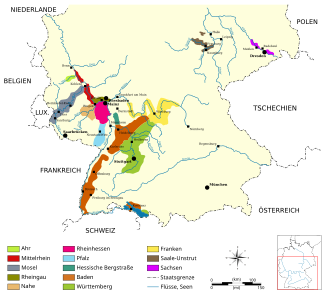
Wines are produced in significant growing regions where vineyards are planted. Wine grapes berries mostly grow between the 30th and the 50th degrees of latitude, in both the Northern and Southern Hemispheres, typically in regions of Mediterranean climate. Grapes will sometimes grow beyond this range, thus minor amounts of wine are made in some rather unexpected places.
Contents
- Countries
- Africa
- Algeria
- Cape Verde
- Morocco
- South Africa
- Tunisia
- South America
- Argentina
- Bolivia
- Brazil
- Chile
- Colombia
- Peru
- Uruguay
- Venezuela
- North America
- Canada
- Costa Rica
- Mexico
- United States
- Europe
- Albania
- Andorra
- Armenia
- Austria
- Azerbaijan
- Belarus
- Belgium
- Bosnia and Herzegovina
- Bulgaria
- Croatia
- Cyprus
- Czech Republic
- Denmark
- Estonia
- France
- Georgia
- Germany
- Greece
- Hungary
- Ireland
- Italy
- Kosovo
- Latvia
- Liechtenstein
- Lithuania
- Luxembourg
- Malta
- Moldova
- Montenegro
- Netherlands
- North Macedonia
- Norway
- Poland
- Portugal
- Romania
- Russia
- San Marino
- Serbia
- Slovakia
- Slovenia
- Spain
- Sweden
- Switzerland
- Turkey
- Ukraine
- United Kingdom
- Asia
- Armenia 2
- Azerbaijan 2
- Burma
- China
- India
- Indonesia
- Iran
- Israel
- Japan
- Kazakhstan
- South Korea
- Lebanon
- Palestinian territories
- Syria
- Turkey 2
- Vietnam
- Oceania
- Australia
- New Zealand
- References
In 2021, the five largest producers of wine in the world were, in order, Italy, France, Spain, the United States, and China.


















